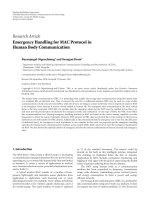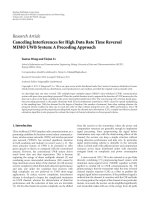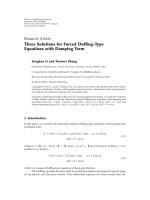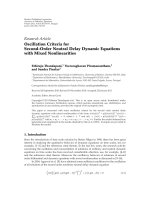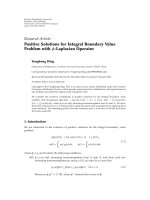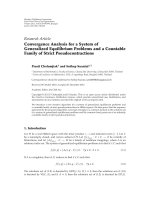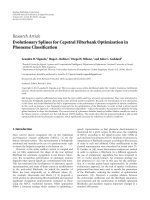Báo cáo hóa học: "Research Article Ergodic Capacity for the SIMO " pdf
Bạn đang xem bản rút gọn của tài liệu. Xem và tải ngay bản đầy đủ của tài liệu tại đây (660.12 KB, 9 trang )
Hindawi Publishing Corporation
EURASIP Journal on Wireless Communications and Networking
Volume 2009, Article ID 802067, 9 pages
doi:10.1155/2009/802067
Research Article
Ergodic Capacity for the SIMO Nakagami-m Channel
Efstathios D. Vagenas, Petros Karadimas, and Stavros A. Kotsopoulos
Wireless Telecommunications Laboratory, Department of Electrical and Computer Engineering, University of Patras,
26500 Rio Patras, Greece
Correspondence should be addressed to Efstathios D. Vagenas,
Received 10 February 2009; Revised 28 May 2009; Accepted 1 July 2009
Recommended by Gabor Fodor
This paper presents closed-form expressions for the ergodic channel capacity of SIMO (single-input and multiple output) wireless
systems operating in a Nakagami-m fading channel. As the performance of SIMO channel is closely related to the diversity
combining techniques, we present closed-form expressions for the capacity of maximal ratio combining (MRC), equal gain
combining (EGC), selection combining (SC), and switch and stay (SSC) diversity systems operating in Nakagami-m fading
channels. Also, the ergodic capacity of a SIMO system in a Nakagami-m fading channel without any diversity technique is derived.
The latter scenario is further investigated for a large amount of receive antennas. Finally, numerical results are presented for
illustration.
Copyright © 2009 Efstathios D. Vagenas et al. This is an open access article distributed under the Creative Commons Attribution
License, which permits unrestricted use, distribution, and reproduction in any medium, provided the original work is properly
cited.
1. Introduction
In recent years, the use of multiantenna systems provides
large spectral efficiency for wireless communications in
the presence of multipath fading environments. Multiple
antennas can be used at the transmitter (MISO), the receiver
(SIMO), or at both of them (MIMO). A SIMO system
can be viewed as an antenna diversity scheme (diversity in
space). Also, diversity combining is known to be a powerful
technique to improve system performance in the presence of
fading [1].
Several papers have been published regarding the capac-
ity of SIMO systems operating in Nakagami environments.
In [2], the channel capacity of a SIMO system in a Nakagami-
m fading channel is presented with the assumption that all
links between transmit and receive antennas are independent
and identically distributed (i.i.d.). In [3], capacity with MRC
and optimal power and rate adaptation is presented while
in [4] Shannon capacity with MRC is derived. In both
of them, the assumption that all links are correlated and
not identically distributed Nakagami holds. In [5], capacit y
of Nakagami-m multipath fading channels with MRC was
studied for different power and rate adaptation policies. Also,
simple capacity formulas for correlated SIMO Nakagami-m
channels were derived in [6]. In [7], an analytical expression
for the capacity of SIMO systems over nonidentically inde-
pendent Nakagami-m channels was derived. Significant work
hasbeendonein[8], where ergodic capacities of MRC, EGC,
SC, and SSC of dual branch diversity systems are presented
in closed-form expressions. The capacity expressions were
obtained by assuming correlated and identically distributed
Nakagami-m links.
In this paper, we examine the ergodic capacity of a SIMO
system operating in independent Nakagami-m channels.
Specifically we derive closed-form expressions for the ergodic
capacity of dual EGC, SC, and SSC systems. For the EGC
and SSC cases, we extend the work in [8] by allowing
the parameter m of the Nakagami-m distribution to take
noninteger values. Moreover for the SSC case, a compact
and quite flexible formula of the ergodic capacity for integer
values of m is presented. For the SC case, we present a new
expression for the ergodic capacity with the assumption that
the Nakagami branches are not identical. Finally, we present
for the first time in international literature the ergodic
capacity of a SIMO system without using any diversity com-
bining technique over independent nonidentical Nakagami-
m branches. In addition, it is shown that when the number
of receive antennas is large, the ergodic capacity of such a
system can be very well approximated by the ergodic capacity
of a Rayleigh channel.
2 EURASIP Journal on Wireless Communications and Networking
The remaining of this paper is organized as follows.
Section 2 introduces a SIMO system. Section 3 examines
the ergodic capacity for each diversity scheme and for the
case where none of diversity technique is applied. Section 4
presents some results, and Section 5 draws the conclusion.
2. System Description
Consider a SIMO system with L receive antennas operating in
independent Nakagami-m channels. The total power of the
complex transmitted signal at a symbol per iod is constrained
to be
S. The received signal vector r at a random symbol
period, assuming that the channel is constant over a symbol
period, is given in a baseband representation as
r
= a ·
(
h
· s + n
)
,(1)
where h
= [h
1
, h
2
, , h
L
]
T
is the L×1 complex channel-gain
vector (T means matrix transposition), a
= [a
1
, a
2
, , a
L
]is
the 1
× L complex antenna-gain vector, and n is the L × 1
zero-mean complex additive white Gaussian (AWGN) vector
with i.i.d. entries and variance N. The received signal can be
written as
r
= s ·
L
i=1
h
i
· a
i
+
L
i=1
n
i
a
i
= s ·
L
i=1
|h
i
|·|a
i
|·e
j(θ
i
+φ
i
)
+
L
i=1
n
i
a
i
= s · g +
L
i=1
n
i
a
i
,
(2)
where h
i
=|h
i
|·e
jθ
i
, a
i
=|a
i
|·e
jφ
i
and g =
L
i
=1
|h
i
|·|a
i
|·
e
j(θ
i
+φ
i
)
. Thus, the received signal-to-noise ratio (SNR) γ over
asymbolperiodis
γ
=
S
N
g
2
L
i=1
|a
i
|
2
. (3)
Assuming that the fading process is ergodic, the ergodic
channel capacity is
C
= W · E
log
2
1+γ
=
W ·
∞
0
log
2
1+γ
p
γ
γ
dγ,
(4)
where W is the bandwidth of the channel, E
· denotes the
ensemble average over γ,andp
γ
(γ) is the probability density
function (PDF) of the SNR γ.
3. Ergodic Channel Capacity
For all the cases listed below, we will assume that all
links between transmitter and receivers
|h
i
| are Nakagami-m
distributed. From [9], their PDF is
p
|h
i
|
(
x
)
=
2m
i
m
i
Γ
(
m
i
)
Ω
m
i
i
x
2m
i
−1
exp
−
m
i
Ω
i
x
2
,(5)
where Γ(x) is the Gamma function [10, eqution (8.310.1)],
Ω
i
= E|h
i
|
2
,andm
i
= Ω
2
i
/E(|h
i
|
2
− Ω
i
)
2
≥1/2.
3.1. Ergodic Channel Capacity of Nakagami-m Fading Chan-
nel w ith MRC. Taking into account the above system
description and assuming that the receiver has full channel
state information (CSI), we choose the phases φ
i
of a
i
,
appeared in (2), as φ
i
=−θ
i
. Also we choose |a
i
|=|h
i
|.
This means that all the signals at the receiver can be added
cophasely and weighted according to the channel g ain. Thus,
(3)becomes
γ
MRC
=
S
N
L
i=1
|h
i
|
2
. (6)
This SNR arises from the MRC diversity technique [1,
equation (9.1)]. Substituting the PDF of (6)in(4)gives
the ergodic capacity of the Nakag a mi-m fading channel
using MRC. Closed-form expressions have been presented
in [3, equation (20)], [4, equation (16)] for the general case
where links are correlated and not identically Nakagami-m
distributed. If the links follow i.i.d. Nakagami-m variables,
the referred equations reduce to [2, equation (36)]. When
the parameter m of i.i.d Nakagami-m branches takes integer
values, the ergodic capacity is given by [5, equation (26)].
A good approximation for the ergodic capacity, where links
are independent and not identically distributed, was given in
[7, equation (16)]. Also a useful expression for the PDF of
γ
MRC
for correlated and not identically distributed links can
be found in [11, equation (18)].
3.2. Ergodic Channel Capacity of Nakagami-m Fading Chan-
nel with Coherent EGC. Taking into account the system
description discussed in Section 2 and assuming that the
receiver has full CSI, we choose phases φ
i
and modulus |a
i
|,
appeared in (2), as φ
i
=−θ
i
, |a
i
(k)|=1foralli.Thus(3)
becomes
γ
EGC
=
S
L · N
⎛
⎝
L
i=1
|h
i
|
⎞
⎠
2
. (7)
This SNR arises using the coherent EGC diversity
technique [1, equation (9.188)]. Substituting the PDF of (7)
in (4) gives the ergodic capacity of the Nakagami-m fading
channel using coherent EGC diversity technique. Finding
analytically the PDF of (7) and consequently the channel
capacity seems to be a ver y difficult problem. In [12], the sum
of i.i.d Nakagami-m variables was studied.
The PDF of the sum of two i.i.d. Nakagami-m variables is
given by [12, equation (4)]. From [13, page 130], we obtain
the PDF transformation p
Y
(x) = p
X
(
√
x/a)/2a
√
x for two
random variables Y , X related as Y
= aX
2
. Using that PDF
transformation in (7)(herea
= S/(L · N)) with the help of
[12, equation (4)], we calculate the PDF of the SNR γ
EGC
.
Thus,thePDFoftheSNRofadualbranchEGCsystemover
i.i.d. Nakagami-m fading channels can be written as
p
γ
EGC
(
x
)
=
√
π Γ
(
2m
)
Γ
2
(
m
)
Γ
(
2m +1/2
)
4
m−1
×
1
γ
2m
x
2m−1
e
−(2/γ)x
1
F
1
2m,2m +
1
2
,
x
γ
,
(8)
EURASIP Journal on Wireless Communications and Networking 3
Table 1
Notation Description
S Total power of a transmitted symbol
N Variance of Gaussian noise
γ Received SNR
C Ergodic capacity
W Bandwidth
γ Average received SNR
γ
th
predetermined threshold of SNR
p
γ
PDF of received SNR
p
F
q
(α
1
, , a
p
; β
1
, , β
q
; x) Generalized hypergeometric series, [10, equation (9.14.1)]
Ψ(x) Digamma function, [10, equation (8.36.1)]
G
m,n
p,q
(x|
a
1
, ,a
p
b
1
, ,b
q
) Meijer’s-G function, [10, page 1032]
γ(α, x) Lower incomplete gamma function, [10, equation (8.350.1)]
Γ(α, x) Upper incomplete gamma function, [10, equation (8.350.2)]
Γ(x) Gamma function, [10, equation (8.310.1)]
where γ = ΩS/mN is the average received SNR, and
1
F
1
(α
1
; β
1
; x) denotes the confluent hypergeometric series,
as in [10, equation (9.21.1)]. Closed-form expressions for
the capacity of a dual branch equal gain combiner with
correlated identically distributed Nakagami-m branches have
been presented in [8, equation (8)]. In the following
paragraph, we extend that ergodic capacity expression for
i.i.d. Nakagami-m branches where the Nakagami parameter
m is not necessarily an integer.
The ergodic capacity of a dual-branch EGC system over
i.i.d. Nakagami-m fading channels (Ω
1
= Ω
2
= Ω and m
1
=
m
2
= m)isgivenby(seeAppendix A)
C
W
=
√
π
ln
(
2
)
Γ
2
(
m
)
4
2m−1
∞
k=0
Γ
2
(
k +2m
)
2
−k
Γ
(
k +2m +0.5
)
k!
×
⎡
⎣
2
γ
2m+k
Γ
(
1−k−2m
)
k+2m
1
F
1
2m + k,2m+k+1,
2
γ
−
ln
2
γ
+ Ψ
(
k +2m
)
+
2/
γ
2m + k − 1
2
F
2
1, 1; 2, 2 − 2m − k,
2
γ
⎤
⎦
,
(9)
where
p
F
q
(α
1
, , a
p
; β
1
, , β
q
; x) is a generalized hyperge-
ometric series, [10, equation (9.14.1)], and Ψ(x)denotes
the digamma function, [10, equation (8.36.1)]. For integer
values of the parameter m,(9) is reduced to (see Appendix A)
C
W
=
√
πe
2/γ
Γ
2
(
m
)
ln
(
2
)
4
2m−1
∞
k=0
Γ
2
(
k +2m
)
2
−k
Γ
(
k +2m +1/2
)
k!
×
2m+k−1
i=0
Γ
−
i,
2
γ
2
γ
i
,
(10)
where Γ(α, x) is the upper incomplete gamma function, as in
[10, equation (8.350.2)]. Taking into account [12, equations
(8), (9) and (10)] and foll owing the same procedure as
in Appendix A (derivation of (9), (10)), we can derive
the ergodic capacity of an equal gain combiner for three,
four, and M i.i.d Nakagami-m branches. However it is
impractical for the purpose of this paper to present all those
tedious mathematical formulations. Nevertheless the impact
of diversity on the capacity can be clearly depicted by using
two branch schemes.
3.3. Ergodic Channel Capacity of Nakagami-m Fading Chan-
nel with SC. We assume a combiner that chooses the branch
with the highest SNR (or equivalently with the strongest
signal assuming equal noise power among the branches).
Thus, we choose the antenna gains appearing in (2)asa
i
= 1
if
|h
i
| > |h
j
| for all j
/
=i and 0 otherwise. Thus, (3)becomes
γ
SC
=
S
N
|h
i
|
2
, |h
i
| >
h
j
∀
j
/
=i. (11)
This is the widely known SC diversity technique as in [1,
Chapter (9.8)]. The PDF of the SNR of two correlated
identically distributed Nakagami-m channels is given in [1,
equation (9.235)], and the resulting ergodic capacity for m
integer is presented in [8, e quation (19)].
From [14, equation (14)] and using the PDF transfor-
mation p
Y
(x) = p
X
(
√
x/a)/2a
√
x for two random variables
Y, X related as Y
= aX
2
(here a = S/N), we can calculate
the PDF of the SNR of two independent and not identically
distributed Nakagami-m branches as follows:
p
γ
SC
(
x
)
=
x
m
1
−1
Γ
(
m
1
)
Γ
(
m
2
)
1
γ
1
m
1
e
−(1/γ
1
)x
γ
m
2
,
1
γ
2
x
+
x
m
2
−1
Γ
(
m
1
)
Γ
(
m
2
)
1
γ
2
m
2
e
−(1/γ
2
)x
γ
m
1
,
1
γ
1
x
,
(12)
where
γ
1
= Ω
1
S/m
1
N, γ
2
= Ω
2
S/m
2
N,andγ(α, x) is the
lower incomplete gamma function, [10, equation (8.350.1)].
4 EURASIP Journal on Wireless Communications and Networking
In order to find the ergodic capacity of a dual SC
system, we have to solve the integral resulting by substituting
(12)in(4). Unfortunately, this integral cannot be solved
analytically when the Nakagami parameters m
1
, m
2
take
noninteger values. But, assuming that m
1
, m
2
take integer
values, the ergodic capacity of a dual-branch SC system over
independent nonidentically distributed Nakagami-m fading
channels is given by (see Appendix A)
C
W
=
e
1/γ
1
ln
(
2
)
m
1
−1
k=0
1
γ
1
k
Γ
−
k,
1
γ
1
+
e
1/γ
2
ln
(
2
)
m
2
−1
k=0
1
γ
2
k
Γ
−
k,
1
γ
2
−
e
1/γ
1
+1/γ
2
ln
(
2
)
Γ
(
m
1
)
γ
2
γ
1
+ γ
2
m
1
m
2
−1
k=0
Γ
(
k + m
1
)
k!
γ
1
γ
1
+ γ
2
k
×
m
1
−1+k
i=0
1
γ
1
+
1
γ
2
i
Γ
−
i,
1
γ
1
+
1
γ
2
−
e
1/γ
1
+1/γ
2
ln
(
2
)
Γ
(
m
2
)
γ
1
γ
1
+ γ
2
m
2
m
1
−1
k=0
Γ
(
k + m
2
)
k!
γ
2
γ
1
+ γ
2
k
×
m
2
−1+k
i=0
1
γ
1
+
1
γ
2
i
Γ
−
i,
1
γ
1
+
1
γ
2
.
(13)
If the branches are identically distributed (Ω
1
= Ω
2
= Ω and
m
1
= m
2
= m), (13)reducesto
C
W
=
2e
1/γ
ln
(
2
)
m−1
k=0
Γ
−
k,
1
γ
1
γ
k
−
2
1−m
e
2/γ
ln
(
2
)
Γ
(
m
)
m−1
k=0
Γ
(
m + k
)
2
k
k!
m+k−1
i=0
Γ
−
i,
2
γ
2
γ
i
.
(14)
3.4. Ergodic Channel Capacity of Nakagami-m Fading Chan-
nel with SSC. We consider a diversity system, for which,
when the SNR of the currently connected branch falls below
a predetermined threshold, the receiver switches to and stays
with another branch, regardless of whether the SNR of that
branch is above or below the predetermined threshold. This
is the widely known SSC diversity technique as in [1,page
419]. In particular, we choose the antenna gains appearing
in (2)asa
i
= 1 if the SNR at the i branch is above a
predetermined threshold γ
th
and 0 otherwise. If the SNR
at the i branch is below the predetermined threshold γ
th
,
then we choose randomly an a
j
= 1where j ∈ (1, L),
j
/
=i.
The PDF of the resulting SNR of a dual-branch SSC
system over two i.i.d. Nakagami-m channels is given in [1,
equation (9.276)]
p
γ
SSC
=
⎧
⎪
⎪
⎪
⎪
⎪
⎪
⎨
⎪
⎪
⎪
⎪
⎪
⎪
⎩
A
1
Γ
(
m
)
1
γ
m
x
m−1
e
−x/γ
, x<γ
th
,
(
A +1
)
1
Γ
(
m
)
1
γ
m
x
m−1
e
−x/γ
, x ≥ γ
th
,
(15)
where A
= 1 − Γ(m,(m/Ω)γ
th
)/Γ(m).
The ergodic capacity of a dual-branch SSC system
over i.i.d. Nakagami-m fading channels is given by (see
Appendix A)
C
W
=
A
ln
(
2
)
1
γ
m
Γ
(
1 − m
)
m
1
F
1
m, m +1,
1
γ
−
ln
1
γ
+ Ψ
(
m
)
+
1
m − 1
1
γ
2
F
2
1, 1; 2, 2 − m,
1
γ
+
e
1/γ
ln
(
2
)
×
∞
k=0
1
Γ
(
m − k
)
k!
−
1
γ
k
×
ln
γ
th
S
N
+1
Γ
m − k, γ
th
m
Ω
+
1
γ
+G
3,0
2,3
⎛
⎝
γ
th
m
Ω
+
1
γ
1,1
0,0,m
−k
⎞
⎠
⎤
⎦
,
(16)
where G
m,n
p,q
(x|
a
1
, ,a
p
b
1
, ,b
q
) is Meijer’s-G function as defined in [10,
page 1032]. For integer values of the para meter m,(16)is
reduced to (see Appendix A)
C
W
=
e
1/γ
ln
(
2
)
A
·
m−1
k=0
Γ
−
k,
1
γ
1
γ
k
+
1
− A
ln
(
2
)
ln
γ
th
S
N
+1
+
1
ln
(
2
)
·
m−1
k=0
Γ
k, γ
th
(
m/Ω
)
+1/
γ
k!
·
Γ
m − k, −1/γ
Γ
(
m − k
)
.
(17)
3.5. Ergodic Channel Capacity of Nakagami-m Fading Chan-
nel with No Diversity Combining Technique. We suppose that
the receiver has no CSI and no complexity (cannot make
any signal processing). Thus, the system operates without
any diversity technique used. Thus, a
i
= 1foralli and the
random variable g (appearing in (3)) is a sum of Nakagami-
m random phase vectors. Consequently, (3)becomes
γ
nodiversity
=
S
L · N
L
i=1
h
i
2
. (18)
EURASIP Journal on Wireless Communications and Networking 5
0
1
2
3
4
5
6
7
Capacity per unit bandwidth (bits/s/Hz)
8
Average received SNR (dB)
0
5
10
15
20
MRC
No diversity
SISO
Figure 1: Capacity per unit bandwidth of a dual branch Nakagami-
m fading channel with MRC diversity as a function of the average
received SNR.
In order to find the PDF of (18), the PDF of the
modulus of the sum of Nakagami-m random phase vectors
is necessary. In [15], that PDF was derived for integer values
of the Nakagami parameter m. Using that result, we write the
modulus of the sum of Nakagami-m random phase vectors
as a sum of weighted Nakagami-m PDFs (see Appendix B).
Thus, using in (18) the PDF transformation p
Y
(x) =
p
X
(
√
x/a)/2a
√
x for two random variables Y, X related as
Y
= aX
2
(here a = S/(L ·N)), we can derive with the help of
(B.6) the PDF of the SNR a s a sum of weighted gamma PDFs,
that is,
p
γ
nodiversity
(
x
)
=
sum
j=0
j! · c
j
· f
x; j +1,
U
L
S
L · N
, (19)
where f (x; k, θ)
= x
k−1
(e
−x/θ
/θ
k
Γ(k)) is the PDF of a
gamma-distributed random variable as in [13, page 87].
The ergodic channel capacity of a SIMO system without
any diversity technique, over independent nonidentically dis-
tributed Nakagami-m branches, is given by (see Appendix A)
C
W
=
e
L·N/U
L
S
ln 2
sum
j=0
j! · c
j
j
i=0
Γ
−
i,
L
· N
U
L
S
L · N
U
L
S
i
. (20)
Herein we will examine the case that the number of
receive antennas is large. In that case the random variable g
(appearing in (3)) tends to be a complex Gaussian random
variable, according to the Central Limit Theorem [13,page
278], that is,
g
=
L
i=1
h
i
=
L
i=1
x
i
+ j
L
i=1
y
i
≈ X + jY, (21)
where x
i
and y
i
are the quadrature components of a
Nakagami-m vector which follow the PDF according to [16,
0
1
2
3
4
5
6
7
Capacity per unit bandwidth (bits/s/Hz)
8
Average received SNR (dB)
0
5
10
15
20
EGC
No diversity
SISO
Figure 2: Capacity per unit bandwidth of a dual branch Nakagami-
m fading channel with EGC diversity as a function of the average
received SNR.
equation (6)]. That PDF has zero mean, and its variance
equals to Ω
i
/2. According to the Central Limit Theorem,
X and Y are zero mean Gaussian random variables with
variance
L
i
=1
(Ω
i
/2). Thus, |g| can be approximated by
a Rayleigh distribution, as defined in [13,page90],with
its parameter σ
=
L
i=1
(Ω
i
/2). Taking into account the
random variables transformation Y
= aX
2
in (18), the
resulting SNR follows an exponential distr ibution [13,page
85], that is,
p
γ
nodiversity
(
x
)
=
1
λ
e
−x/λ
, (22)
where λ
= (S/N · L)
L
i=1
Ω
ι
. Substituting (22)in(4)and
using Theorem 3,weobtain
C
W
=
e
1/λ
ln
(
2
)
Γ
0,
1
λ
. (23)
Thus, when L is large (asymptotic analysis), the ergodic
capacity of the SIMO system can be approximated by the
simple formula of (23), which is in fact the capacity of a
Rayleigh channel [2, equations (21), ( 22)].
4. Results
Figure 1 shows the capacity per unit bandwidth for a dual
branch MRC system over i.i.d. Nakagami-m fading channels
(see [2, equation (36)]) for the case m
1
= m
2
= m = 2,
Ω
1
= Ω
2
= Ω = 1. Also, channel capacity without any
diversity technique (see (20)) and SISO channel capacity (see
[2, equation (21)]) are presented for comparison. It is clear
that MRC improves the capacity of a SIMO Nakagami-m
fading channel. It is also remarkable that channel capacity
with none diversity technique is much greater than SISO
capacity.
6 EURASIP Journal on Wireless Communications and Networking
0
1
2
3
4
5
6
7
Capacity per unit bandwidth (bits/s/Hz)
Average received SNR (dB)
0
5
10
15
20
SC
No diversity
SISO
Figure 3: Capacity per unit bandwidth of a dual branch Nakagami-
m fading channel with SC diversity as a function of the average
received SNR.
Figure 2 shows the capacity per unit bandwidth for a dual
branch EGC system over i.i.d. Nakagami-m fading channels
(see (10)) for the same parameter set as in Figure 1. Again,
channel capacity without any diversity technique and SISO
channel capacity are presented for comparison. It is obvious
that EGC improves the capacity of a SIMO Nakagami-m
fading channel.
Figure 3 shows the capacity per unit bandwidth for a dual
branch SC system over independent Nakagami-m fading
channels (see (13)) for the same parameter set as in Figures
1 and 2. Channel capacity without any diversity technique
and SISO channel capacity are presented for comparison. We
can see that SC performs slightly better than the case of none
diversity technique.
Figure 4 shows the capacity per unit bandwidth for a dual
branch SSC system over independent Nakagami-m fading
channels (see (17)), for the same parameter set as in Figures
1, 2,and3. The optimum adaptive switching threshold was
determined as in [8, equation (31)] and was found γ
th
= 0.8.
Channel capacity without any diversity technique and SISO
channel capacity are presented for comparison. It is clear that
SSC improves the capacity of a SIMO Nakagami-m fading
channel, but the case of none diversity technique performs
slightly better than SSC. This is because SSC does not exploit
both branches simultaneously. Essentially, SSC cannot have
diversity gain. It simply uses one branch which has a smaller
possibility to fall below a predetermined threshold (as it hops
to the other).
Figure 5 shows the capacity per unit bandwidth for
a five and a dual branch system where none diversity
technique is used. Each branch is assumed to be independent
and is characterized as Nakagami-m fading channel with
parameters m
i
= 2andΩ
i
= 1. Figure 5 shows that (23)gives
a very good approximation of (20) for the channel capacity
of a SIMO Nakagami-m fading channel even with L
= 5
receive antennas.
0
1
2
3
4
5
6
7
Capacity per unit bandwidth (bits/s/Hz)
Average received SNR (dB)
0
5
10
15
20
No diversity
SISO
SSC
Figure 4: Capacity per unit bandwidth of a dual branch Nakagami-
m fading channel with SSC diversity as a function of the average
received SNR.
Average received SNR (dB)
Capacity per unit bandwidth (bits/s/Hz)
Asymptotic analysis
No diversity (20)
L = 5 receive antennas
L = 2 receive antennas
(23)
1
2
3
4
5
6
7
8
0
5
10
15
20
9
Figure 5: Capacity per unit bandwidth of a Nakagami-m fading
channel with L
= 5andL = 2 receive antennas without any diversity
technique as a function of the average received SNR.
5. Conclusions
We have investigated the ergodic capacity of a SIMO system
operating in a Nakagami-m fading channel. We have derived
a closed-form expression for the ergodic capacity of a dual
branch EGC system over i.i.d Nakagami-m branches, where
the Nakagami parameter m can be any real number with m
≥
1/2. Also, a closed-form formula is presented for m integer.
A simple closed-form expression for the ergodic capacity of
a dual SC diversity system operating in two independent
but not identically distributed Nakagami-m branches has
been derived. For that case, we have assumed that the
Nakagami parameters m
i
take integer values. A closed-form
expression for the ergodic capacity of a dual SSC diversity
EURASIP Journal on Wireless Communications and Networking 7
system operating in two i.i.d. Nakagami-m branches has been
derived for the case where the Nakagami parameter m can be
any real number with m
≥ 1/2. Also, a simple closed-form
formula is presented for m integer. It was observed that all
diversity combining techniques that are considered in this
paper provide improvement to the capacity of Nakagami-
m fading channels. Finally, the ergodic capacity of a SIMO
system without any diversity technique has been presented
in a closed-form expression. For that case, we have assumed
L independent but not identically distributed Nakagami-m
branches, where the parameters m
i
take integer values. It was
shown that when the number of receive antennas is large
(L
≥ 5), the ergodic capacity of a SIMO system without
any diversity technique can be very well approximated by the
capacity of a Rayleigh fading channel.
Appendices
A.
Theorem 1. One has
∞
c
ln
(
1+x
)
x
n−1
e
−bx
dx
= e
b
Γ
(
n
)
∞
k=0
(−1)
k
Γ
(
n − k
)
k!
×
ln
(
c+1
)
Γ
(
n−k, b
(
c+1
))
+G
3,0
2,3
b
(
c+1
)
|
1,1
10,0,n
−k
(A.1)
for n
∈ R, b>0 and c>−1.
Theorem 2. One has
∞
c
ln
(
1+x
)
x
n−1
e
−bx
dx
= ln
(
c +1
)
Γ
(
n, bc
)
b
−n
+ b
−n
Γ
(
n
)
n−1
q=0
Γ
q, b
(
c +1
)
q!
Γ
n − q, −b
Γ
n − q
(A.2)
for n
∈ N, b>0 and c>−1.
Theorem 3. One has
∞
0
ln
(
1+x
)
x
n−1
e
−bx
dx = Γ
(
n
)
e
b
b
−n
n
−1
k=0
b
k
Γ
(
−k, b
)
for b>0, n
∈ N.
(A.3)
Proof of Theorem 1. We define I
c
(n, b) =
∞
c
ln (1 +
x) x
n−1
e
−bx
dx. With a change of variables we have
I
c
(
n, b
)
= e
b
∞
c+1
ln
(
x
)
(x −1)
n−1
e
−bx
dx. (A.4)
We write the term (x
−1)
n−1
to its Taylor series expansion as
(x
− 1)
n−1
=
∞
k=0
(Γ(n)(−1)
k
/Γ(n − k)k!)x
n−1−k
,and(A.4)
becomes
I
c
(
n, b
)
= e
b
Γ
(
n
)
∞
k=0
(−1)
k
Γ
(
n − k
)
k!
∞
c+1
ln
(
x
)
x
n−1−k
e
−bx
dx.
(A.5)
The integral of (A.5) is solved by Mathematica Toolbox as
∞
c
ln
(
x
)
x
n−1
e
−bx
dx
= b
−n
ln
(
c
)
Γ
(
n, bc
)
+ G
3,0
2,3
bc|
1,1
0,0,n
.
(A.6)
Substituting (A.6)in(A.5), we obtain (A.1).
Proof of Theorem 2. Using partial integration and [10,equa-
tion (8.356.4)], the integral I
c
(n, b)canbewrittenas
I
c
(
n, b
)
=−
∞
c
ln
(
1+x
)
Γ(n, bx)
b
n
dx
= ln
(
c +1
)
Γ
(
n, bc
)
b
−n
+ b
−n
∞
c
Γ
(
n, bx
)
x +1
dx.
(A.7)
If n is an integer (n
∈ N), using [10, equation (8.352.7)],
(A.7)becomes
I
c
(
n, b
)
= ln
(
c +1
)
Γ
(
n, bc
)
b
−n
+ b
−n
Γ
(
n
)
n−1
k=0
b
k
k!
∞
c
x
k
e
−bx
x +1
dx.
(A.8)
The integral of (A.8) can be w ritten with the help of [10,
equation (1.111)] a s
∞
c
x
k
e
−bx
x +1
dx
= e
b
∞
c+1
(x −1)
k
e
−bx
x
dx
= e
b
k!
k
q=0
(−1)
k−q
q!
k − q
!
∞
c+1
x
q−1
e
−bx
dx
(A.9)
and by the definition of the upper incomplete gamma
function [10, equation (8.350.2)], (A.9)becomes
∞
c
x
k
e
−bx
x +1
dx
= (−1)
k
e
b
k!
k
q=0
(−b)
−q
q!
k − q
!
Γ
q, b
(
c +1
)
.
(A.10)
Replacing (A.10)in(A.8), we have that
I
c
(
n, b
)
= ln
(
c +1
)
Γ
(
n, bc
)
b
−n
+ e
b
b
−n
Γ
(
n
)
n−1
k=0
k
q=0
(−b)
k−q
q!
k − q
!
Γ
q, b
(
c +1
)
.
(A.11)
Reversing the double sum of (A.11) and using [10,equation
(8.352.4)], we obtain (A.2).
8 EURASIP Journal on Wireless Communications and Networking
Proof of Theorem 3. We set c
= 0in(A.8)andwehave
I
0
(
n, b
)
= Γ
(
n
)
b
−n
n
−1
k=0
b
k
k!
∞
0
x
k
e
−bx
x +1
dx. (A.12)
Solving the integral in the second part of (A.12) with the help
of [10, equation (8.353.3)], we obtain (A.3).
Derivation of (9) and ( 10 ). Substituting (8)in(4)and
replacing the confluent hypergeometric function of (8)with
its infinite series representation [10, equation (9.210.1)], we
obtain after some manipulations
C
W
=
√
π
ln
(
2
)
Γ
2
(
m
)
4
m−1
1
γ
2m
×
∞
k=0
Γ
(
k +2m
)
Γ
(
k +2m +0.5
)
k!
1
γ
k
×
∞
0
ln
(
1+x
)
x
2m−1+k
e
−(2/γ)x
dx.
(A.13)
The integral appearing in (A.13) was solved in [17,equation
(2.6.23.4)]. Using this result, after some manipulations, (9)is
derived. If m in (A.13) is an integer, we evaluate the integral
of (A.13) by using Theorem 3 and after some manipulations,
(10) arises.
Derivation of (13). Assuming that m
1
and m
2
take integer
values, we are able to replace the lower incomplete gamma
function γ(α, x), appearing in (12), with its finite sum
representation [10, equation (8.352.1)]. Substituting (12)in
(4) with the help of [10, equation (8.352.1)], we obtain after
some manipulations
C
W
=
1
ln
(
2
)
Γ
(
m
1
)
1
γ
1
m
1
I
0
m
1
,
1
γ
1
+
1
ln
(
2
)
Γ
(
m
2
)
1
γ
2
m
2
I
0
m
2
,
1
γ
2
−
1
ln
(
2
)
Γ
(
m
1
)
1
γ
1
m
1
×
m
2
−1
k=0
1
k!
1
γ
2
k
I
0
m
1
+k,
1
γ
1
+
1
γ
2
−
1
ln
(
2
)
Γ
(
m
2
)
1
γ
2
m
2
×
m
1
−1
k=0
1
k!
1
γ
1
k
I
0
m
2
+ k,
1
γ
1
+
1
γ
2
.
(A.14)
Since m
1
and m
2
in (A.14) are integers, we use Theorem 3 of
the current Appendix to solve the integral I
0
(n, b)andfinally,
we obtain (13).
Derivation of (16) and (17). Substituting (15)in(4), with
the help of (A.4), we obtain
C
W
=
A
ln
(
2
)
Γ
(
m
)
1
γ
m
I
0
m,
1
γ
+
1
ln
(
2
)
Γ
(
m
)
1
γ
m
I
γ
th
m,
1
γ
.
(A.15)
Using Theorem 1 to evaluate the integral I
c
(n, b) and con-
sidering that the integral I
0
(n, b) was solved in [17,equation
(2.6.23.4)], from (A.15)weobtain(16).
For integer values of the Nakagami parameter m in
(A.15), we are able to use Theorems 2 and 3 to solve
the integrals I
c
(n, b)andI
0
(n, b), respectively. After some
manipulations, from (A.15)weobtain(17).
Derivation of (20). Replacing (19)in(4), we obtain after
some manipulations
C
W
=
1
ln
(
2
)
sum
j=0
c
j
(−1)
j
j!
N
U
L
S
j+1
∞
0
ln
(
1+x
)
x
j
e
−(N/U
L
S)x
dx.
(A.16)
Using Theorem 3, we can solve the integral of (A.16)and
finally we obtain (20).
B.
If H =
L
i=1
h
i
is a sum of Nakagami-m random phase
vectors, the PDF of its modulus has been derived in [15,
equation (8)] as
p
|H|
(
r
)
= G
2r
2 j+1
e
−r
2
/U
L
U
j+1
L
,(B.1)
where U
L
=
L
k
=1
(Ω
k
/m
k
)andGZ is an operator defined
as [15,equation(4)]
G
Z
m
1
−1
i
1
=0
···
m
L
−1
i
L
=0
S
L
j=0
L
k
=1
(
1
−m
k
)
i
k
/(i
k
!)
2
(
−S
L
)
j
S
L
!Y
L
·Z
j!
2
(
U
L
/4
)
S
L
(B.2)
with S
L
=
L
k
=1
i
k
, Y
L
=
L
k
=1
(Ω
k
/4m
k
)
i
k
.(z)
n
is the
Pochhammer symbol, [18, equation (6.1.22)]. Reversing the
multiple sum in (B.2), we can rewrite G
Z as
G
Z=
sum
j=0
Z·
m
1
−1
i
1
=0
···
m
L
−1
i
L
=0
L
k=1
(
1
−m
k
)
i
k
/(i
k
!)
2
(
−S
L
)
j
S
L
!Y
L
j!
2
(
U
L
/4
)
S
L
=
sum
j=0
Z · c
j
(B.3)
with the constraint that
L
k
=1
i
k
≥ j and sum =
L
k
=1
m
k
−L.
Thus, c
j
is defined as
c
j
m
1
−1
i
1
=0
···
m
L
−1
i
L
=0
L
k
=1
i
k
≥j
(
−S
L
)
j
S
L
!Y
L
j!
2
(
U
L
/4
)
S
L
L
k=1
(
1
− m
k
)
i
k
(i
k
!)
2
. (B.4)
EURASIP Journal on Wireless Communications and Networking 9
Using the property (
−z)
n
= (−1)
n
(z − n +1)
n
for the
Pochhammer symbol, (B.4)canbewrittenas
c
j
=
(
−1
)
j
( j!)
2
m
1
−1
i
1
=0
···
m
L
−1
i
L
=0
L
k
=1
i
k
≥j
(
−U
L
)
−S
L
(S
L
!)
2
S
L
− j
!
×
L
k=1
Γ
(
m
k
)
(i
k
!)
2
Γ
(
m
k
− i
k
)
Ω
k
m
k
i
k
.
(B.5)
Substituting (B.3)in(B.1) with the help of (B.5)weobtain
p
|H|
(
r
)
=
sum
j=0
2r
2 j+1
e
−r
2
/U
L
U
j+1
L
c
j
,(B.6)
which is, in fact, a sum of weighted Nakagami-m PDFs, as the
author of [15] has noted.
References
[1] M. K. Simon and M S. Alouini, Digital Communications over
Fading Channels, John Wiley & Sons, New York, NY, USA,
2005.
[2] F. Zheng and T. Kaiser, “On the channel capacity of multi-
antenna systems with nakagami fading,” EURASIP Journal on
Applied Signal Processing, vol. 2006, Article ID 39436, 11 pages,
2006.
[3] M S. Alouini, A. Abdi, and M. Kaveh, “Sum of gamma vari-
ates and performance of wireless communication systems over
Nakagami-fading channels,” IEEE Transactions on Vehicular
Technology, vol. 50, no. 6, pp. 1471–1480, 2001.
[4] G. K. Karagiannidis, N. C. Sagias, and T. A. Tsiftsis, “Closed-
form statistics for the sum of squared Nakagami-m variates
and its applications,” IEEE Transactions on Communications,
vol. 54, no. 8, pp. 1353–1359, 2006.
[5] M S. Alouini and A. J. Goldsmith, “Capacity of Nakagami
multipath fading channels,” in Proceedings of the 47th IEEE
Vehicular Technology Conference (VTC ’97), vol. 1, pp. 358–
362, Phoenix, Ariz, USA, May 1997.
[6]Q.T.ZhangandD.P.Liu,“Simplecapacityformulasfor
correlated SIMO Nakagami channels,” in Proceedings of the
57th IEEE Vehicular Technology Conference (VTC ’03), vol. 1,
pp. 554–556, Jeju, Korea, April 2003.
[7] A. M. Magableh and M. M. Matalgah, “Capacity of SIMO
systems over non-identically independent Nakagami-m chan-
nels,” in IEEE Sarnoff Symposium (SARNOFF ’07), pp. 1–5,
Princeton, NJ, USA, April-May 2007.
[8] S. Khatalin and J. P. Fonseka, “Capacity of correlated
Nakagami-m fading channels with diversity combining tech-
niques,” IEEE Transactions on Vehicular Technology, vol. 55, no.
1, pp. 142–150, 2006.
[9] M. Nakagami, “The m-distribution—a general formula on
intensity distribution of rapid fading,” Statistical Methods in
Radio Wave Propagation, vol. 40, pp. 757–768, 1962.
[10] I. S. Gradshteyn and I. M . Ryzhik, Table of Integrals, Series and
Products, Academic Press, New York, NY, USA, 7th edition,
2007.
[11] M. Z. Win and J. H. Winters, “On maximal ratio combining in
correlated Nakagami channels withunequal fading parameters
and SNRs among branches: an analytical framework,” in
Proceedings of IEEE Wireless Communications and Networking
Conference (WCNC ’99), pp. 1058–1064, New Orleans, La,
USA, September 1999.
[12] P. Dharmawansa, N. Rajatheva, and K. Ahmed, “On the
distribution of the sum of Nakagami-m random variables,”
IEEE Transactions on Communications, vol. 55, no. 7, pp. 1407–
1416, 2007.
[13] A. Papoulis, Probability, Random Variables and Stohastic
Processes, McGraw-Hill, New York, NY, USA, 4th edition.
[14] G. Fedele, L. Izzo, and M. Tanda, “Dual diversity reception
of M-ary DPSK signals over Nakagami fading channels,”
in Proceedings of the 6th IEEE International Symposium on
Personal, Indoor and Mobile Radio Communications (PIMRC
’95), vol. 3, pp. 1195–1201, Toronto, Canada, September 1995.
[15] G. K. Karagiannidis, “A closed-form solution for the distribu-
tion of the sum of Nakagami-m random phase vectors,” IEEE
Communications Letters, vol. 10, no. 12, pp. 828–830, 2006.
[16] G. Fraidenraich, O. Leveque, and J. M. Cioffi
, “On the MIMO
channel capacity for the Nakagami-m Channel,” in Pro ceedings
of IEEE Global Telecommunication Conference (GLOCOM ’07),
pp. 3612–3616, Washington, DC, USA, November 2007.
[17] A. P. Prudnikov, Y. A. Brychkov, and O. I. Marichev, Integrals
and Series, vol. 1, Gordon and Breach Science, Amsterdam,
The Netherlands, 1986.
[18] M. Abramovitz and I. A. Stegun, Handbook of Mathematical
Functions with Formulas, Graphs, and Mathematical Tables,
Dover, New York, NY, USA, 9th edition, 1972.

